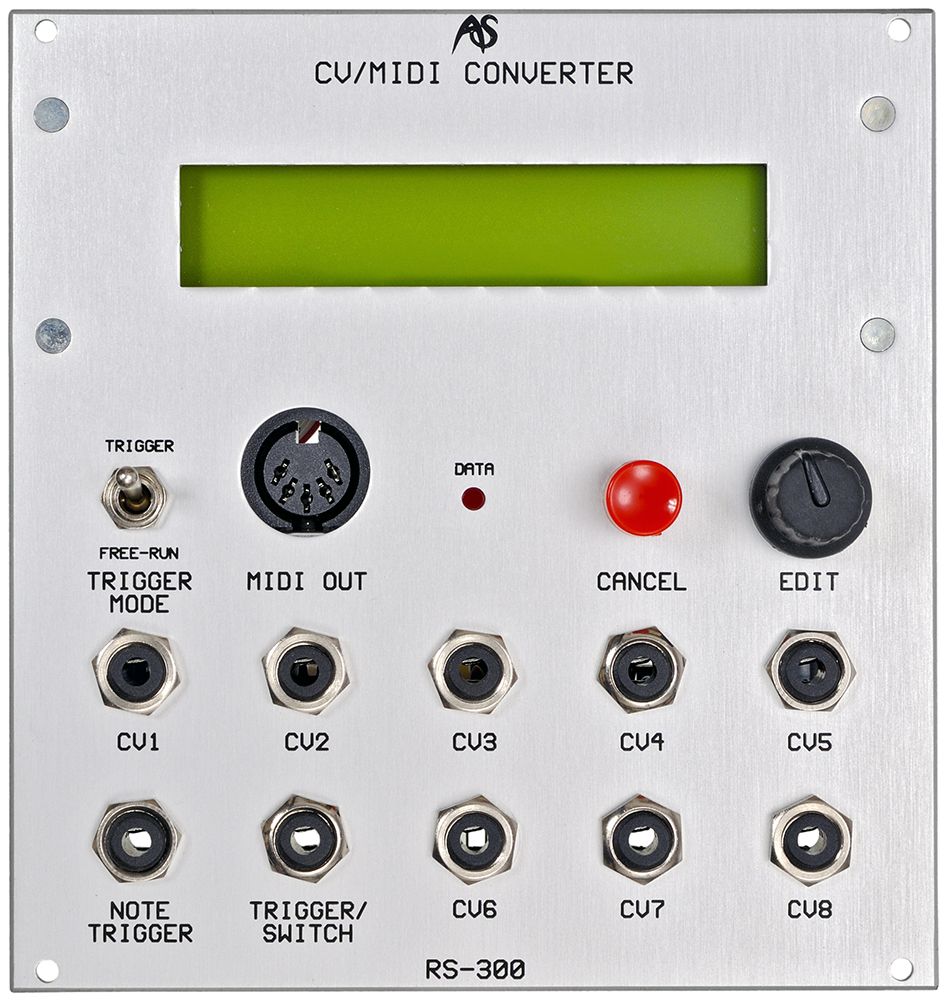Analogue Systems
RS-300
CV to MIDI
CV to MIDI converter with note on note off capabilities. Eight C.V. inputs fully programmable for various midi controllers including velocity and aftertouch. In conjunction with an analogue sequencer and a rhythm machine live drum programming and performance is easily obtainable.
Not long after the introduction of MIDI in 1983, players demanded the ability to control their analogue CV+Gate synthesisers using MIDI keyboards and the new breed of MIDI hardware and software sequencers. Many manufacturers responded, and there was soon a plethora of MIDI-to-CV converters available, some monophonic, some polyphonic, but all capable of playing appropriately equipped CV+ Gate synthesizers. Some of these converters also incorporated dedicated LFOs that added pitch modulation, and many also interpreted MIDI controllers such as Modulation, Breath Controller, Volume,and so on.Nonetheless, all MIDI/CV converters are unidirectional. In other words, they convert MIDI data into analogue voltages, but do not convert analogue control voltages into MIDI. In fact, other than the RS-300,we are unaware of any CV/MIDI converter designed specifically to accept analogue voltages and output MIDI messages that allow you to control your digital keyboards and modules using analogue synthesizers,sequencers and controllers.The possibilities of this are enormous. Analogue synthesis offers modulation possibilities that are far beyond those of most digital instruments, so an RS Integrator fitted with the RS-300 extends the capabilities of modern workstations and synthesizers. In addition, you can use analogue controllers such as the Analogue Systems French Connection to control MIDI instruments in ways that are not possible using conventional keyboards
In use :
NAVIGATION
The RS-300 is controlled by the menus displayed on its 2 line x 20 character LCD. This display is backlit to aid its use in darkened conditions.There are twelve menus (those for inputs 3 to 8 are identical, so are grouped in the diagram above) and these offer access to the sub-menus (not shown).
- Navigate through the menu structure by rotating the EDIT knob.
- Select a menu by pressing the EDIT knob.
- Navigate through any menu by rotating the EDIT knob.
- Move "down" to select a sub-menu or list of options by pressing the EDIT knob.
- Alter a value by rotating the EDIT knob.
- Return to the previous menu by pressing the EDIT knob.
- Jump "up" a level from a sub-menu to a main menu by pressing CANCEL.
- Leave an option or parameter unchanged and return to the menu containing it by pressing CANCEL.
Show inputs :
Displays the MIDI note (if any) and controller values generated by the CVs and trigger/switch voltages presented to the ten analogue inputs.
Output type
- Note on/off: The MIDI data sent is a note ON of the pitch shown in the input display. A new note will be sent whenever there is a transition,and will be marked by an asterisk"*" in the top right of the display.
- Pitch wheel: The MIDI data sent is a pitch-bend message.
- Aftertouch: The MIDI data sent is an aftertouch message.
- CC#0 - CC#127: The MIDI data sent is a continuous controller message on the selected CC number.
Input voltage range
Four voltage ranges are provided:
- -10V to +10V
- -5V to +5V
- 0Vto+10V
- 0Vto+5V
Set the range to the most appropriate for the signal being presented to the CV1 input.
